|
The
Smith & Wesson .500 Magnum revolver
has been around now for over four years, and
I have to admit that until last weekend I hadn’t fired one.
I was a little intrigued when the .500 was introduced by
the fact that Smith & Wesson would once again be producing
the “World’s Most Powerful Revolver.”
I like big bore revolvers so I thought it was somewhat
neat, but I live here in St. Louis where the bears are in the
zoo or maybe in Chicago unless they play the Rams here in town.
I know that some farmers or ranchers carry big bore
revolvers in case they have to kill a bull, but here in the
city, those are the tall guys that play basketball in Chicago.
I don’t really have any need for a .500 Magnum
revolver. Of
course, I don’t really have a need for lots of guns I own!
But since I don’t hunt big game with a handgun, run a
trap line in Alaska, or raise fighting bulls on the Mexican
border, I just didn’t have a reason to get interested in the
.500 Magnum.
However,
when John Ross began formulating his ideas for his
special limited run Performance Center .500 Magnum I got
interested. John
and I shoot together maybe once or twice a year, but he always
brings along big blasters and shoots them well at longer ranges.
I also know that he is considered the “Go-To-Guy” on
the internet with questions about shooting and loading
the S&W .500 Magnum. John
has had quite a few of the guns and has developed lots of loads
for them. He’s
certainly shot them more than most.
I also listened when we ended up together to his thoughts
on the .500 Magnum. I
was interested to learn, for example, that the .500 shoots
flatter and more accurately than the Model 29.
I actually have always been a .41 Magnum shooter because
I like the fact the round shoots flatter than the .44 Magnum so
I was impressed the .500 shot flat.
Most
people who bought a .500 S&W revolver during the first
couple of years probably fired it a couple of times, but John
kept firing them, buying them, and tinkering with them.
In the process, he came to some conclusions about what
would be the optimum S&W .500 Magnum for someone who really
planned on using the revolver.
Once he had organized his thoughts and made a couple of
prototypes, he contacted the Smith & Wesson Performance
Center to see if they would build 500 guns to his specs.
They said they could; they have; and I picked mine up a
couple of weeks ago. A
combination of things convinced me to purchase one of these
guns. First, I
appreciated how much thought John had put into the gun.
I also like the look of the gun.
With its 5 inch barrel and half lug it is sort of like my
5” half lug 686 on steroids.
I also did some rationalization: I’m a gun writer who
does a lot of handgun articles; hence, I should have a .500
S&W revolver.
I
will tell you now that I am very happy with my John Ross PC
.500, but I’ll go into more detail on that later.
First, let me take a brief look at the revolver’s
special features and John’s rationale for those features.
The
barrel is 5 inches long with a half lug/ejector shroud.
This combo makes for excellent balance yet still offers
good ballistic performance.
The barrel has a twist of 1 in 10
to stabilize longer, heavier bullets at long range.
To get a tight cylinder gap, the John Ross Performance
Center revolver uses an external muzzle nut which allows a
cylinder gap of only .0035-.0045 inches to be achieved.
The gain is about 100 feet per second.
This muzzle nut replaces the compensator, which John
feels actually makes the .500 more unpleasant to shoot due to
blast, though recoil/muzzle flip does go up somewhat.
A Millet dovetail front sight was chosen as one
that could be switched out by a gunsmith to allow for a
different load but which would stay in place despite heavy
recoil. Originally. John wanted a black
Melonite finish for the Ross PC .500 but it was not a good
choice for a cylinder which will have to consistently stand up
60,000 psi. Due to
the production process Smith & Wesson uses on the frames, it
was determined that Melonite was not a good choice there either.
As a result, there will be 250 of the revolvers in satin
stainless and 250 in black oxide with a satin stainless
cylinder. Note that
Smith & Wesson requires a minimum order of 500 guns for a
special production run such as this one.
The grips are the Hogue Sorbothane ones standard
on factory .500 Magnums and do a good job of soaking up recoil.
John felt that these were a good choice since many
shooters will install the custom grips of their choice in any
case.
Those
are the basic special features of the John Ross Performance
Center .500 Magnum. Since
the revolvers are in a special serial number range
running JRC0XXX for the all stainless guns and JRA0XXX
for the guns with black frames, one can have some choice of
serial number.
Some are already spoken for; for example, I took JRC00XX
with the last digits of my year of birth.
My
revolver came in as part of the first batch John received from
the Performance Center so, actually, other than John’s own
gun, mine was the first one delivered.
Since I was relatively unfamiliar with the .500 Magnum,
when I took my revolver out of the Performance Center soft case,
my first reaction was--it’s big!
But even with the 2.3 inch cylinder, the John Ross
Performance Center revolver looks symmetrical.
The X-frame is hefty, but the gun does remind me of a
scaled up version of my 5” 686 which I mentioned earlier.
I was also surprised at how well it balances despite
weighing 57 ounces. I
gather this is still about a pound less than standard .500
Magnums. Generally,
I am not a fan of rubber grips on revolvers; however, since I
had not shot a .500 Magnum before, I figured I’d appreciate
their cushioning effect.
Cor-Bon
became involved early in the development process for the .500
Magnum round and since I have always found Cor-Bon ammo
accurate, powerful, and reliable, I ordered some of each bullet
weight Cor-Bon loads in both .500 Special and .500 Magnum.
For anyone not familiar with these two loads, let me
point out that the .500 Special loadings may be viewed as
equivalent to .38 special rounds for the .357 Magnum or .44
Special rounds for the .44 Magnum.
They use shorter cases and are less powerful. “Less
powerful” is a relative term here, though, since a 350 grain
Cor-Bon .500 Special has an advertised muzzle velocity of 1350
fps and muzzle energy of 1417 ft lbs.
Basically, the .500 Special is equivalent to a high end
.44 Magnum load. The
350 grain Cor-Bon .500 Magnum produces a muzzle velocity of 1600
fps and a Muzzle Energy of 1990 ft lbs.
Cor Bon offers other weights including a 500 grain .500
Magnum load and a 275 grain DPX load.
For these initial tests, I decided to use the two 350
grain loads and the 275 grain DPX.
I figured I’d work up to the 500 grain Magnum load next
shooting session!
A
friend of mine whose John Ross PC .500 revolver has not come in
yet asked me if he could take mine to the indoor range to whet
his appetite for his revolver.
Since he normally shoots tighter 25 yard groups than I do
I agreed as I felt that would let me see how well the guns shot.
Using the 275 grain DPX .500 Magnum load, he put three
shots into about 3 inches.
With the 350 grain Cor-Bon .500 Special load, his best 25
yard group was more like 3.5 inches.
I felt both groups were good for a first firing session
with a new and rather daunting gun.
I should note, too, that muzzle flip was substantial
enough when my friend fired .500 Magnum loads from a hand held
rest, he cut a notch in his head with the rear sight!
I
got my first chance to shoot the John Ross revolver this past
weekend.
I started off with 24 rounds of .500 Special to get used
to the gun. My best
5-shot off hand group (a full cylinder on the .500) at 25 yards
was over 5 inches, but I was more interested in getting used to
the gun. Recoil
wasn’t really as bad as I expected.
I would say it was no more than that with my S&W 329
and full house .44 Magnum loads.
Muzzle flip was noticeable but not as bad as shooting my
S&W 360PD with 125 grain JHPs.
I fired one cylinder specifically on plates at ranges
between 25 and 35 yards to see how fast I could recover from
recoil and muzzle flip and found that the Ross .500’s
excellent balance helped a lot.
A friend of mine who was shooting with me tried the
revolver on double action for five rounds and found the trigger
pull rather heavy. I
find with revolvers that have a lot of recoil I notice it more
when my hand/arm tighten up for the double action pull.
This is probably just a subjective thing, but I chose not
to try DA this first session.
John had decided not to have the Performance Center do a
trigger job on the Ross .500s so pull is good but not great.
I wish he would have gone for the trigger job, but it
would have increased wait time for the guns and price.
It
was with some trepidation that I go ready to fire my first .500
magnum rounds. I
was using the 350 grain Cor-Bon .500 Magnum loads as I wanted to
compare recoil and muzzle flip to the .500 Special with the same
weight bullets. Having
learned from my friend’s example, I did not try firing it from
a rest but fired off hand.
Recoil was cushioned quite well by the rubber grips, but
muzzle flip was enough that it came somewhere between 60 and 90
degrees from horizontal. John
Ross is a big guy and he shoots hot handloads a lot with his
.500 Magnums and doesn’t feel muzzle flip is an issue.
I will say that I weigh over 200 lbs and was at one time
a competitive weightlifter who could military press 300 lbs and
bench press 350 lbs. My
point is I have strong arms and I specifically got a good strong
hold on the gun so it didn’t dent my head.
With either .500 Special or .500 Magnum loads, you will
know you have shot a powerful revolver.
I did not, however, find the experience unpleasant.
I think John was bang on with the idea that the blast
from the muzzle brake is actually more noticeable than recoil.
Along
with the revolver and Cor-Bon ammo, I also brought along to test
the prototype holster for the John Ross PC .500 Magnum which Ken
Null had fabricated. Cleverly
designed so that it can be worn as a strongside hip holster or a
crossdraw, the holster shows all of Ken Null’s usual
craftsmanship and is designed to allow the Ross .500 to be
easily carried in the field.
I’ve
never been one to fire hundreds of rounds of .44 Magnum at a
session and I will not be one to fire more than a couple of
dozen rounds of .500 Magnum at a session, but I did enjoy myself
and will shoot the 500 grain .500 loads on my next outing.
I like my John Ross Performance Center .500 Magnum a lot.
It will probably remain my only .500 Magnum, though when
the black-with-stainless cylinder revolver comes in with the
same serial number as my satin stainless one, I think I will
have to fight temptation. I
will also have to raise some money.
Dealer price on the John Ross Performance Center .500
Magnum is $1395 plus shipping.
Along with the revolver, one gets a booklet written by
John that traces the history of big bore revolver development, his
experiments with the .500 Magnum, and the
evolution of the concept for this revolver.
I read this booklet from cover to cover and was
fascinated the entire time.
This is a case where I think the gun is definitely worth
the price. The Ross
PC .500 Magnum was developed as a shooter’s revolver, but I
think the fact it has the special features and is a limited
production item will also make it a collector’s item.
To
order, contact John Ross at www.john-ross.net
or call him at (314) 308-8261.
I would recommend that if you want one of these
revolvers, especially with a special serial number, that you
call or e-mail quickly. This is the first article to appear on the
guns so you will have a head start, but I really don’t think
they will last long.
Other
Contact Information
Cor-Bon
Ammunition - www.corbon.com
Ken
Null Holsters - www.klnullholsters.com
Leroy
Thompson
UPDATE
August 10th, 2007
John
Ross adds the following note:
Leroy wished I'd had trigger jobs done at the
factory. These guns have the lightest SA trigger that the
company is willing to deliver. The Performance Center will
not build a .500 with as light a trigger as they will put on a
.357. They don't want the gun to get away from a shooter
that isn't ready for it to fire.
John Ross
  
Got something to say about this article? Want to agree (or
disagree) with it? Click the following link to go to the GUNBlast Feedback Page.
|
|
Click pictures for a larger version.
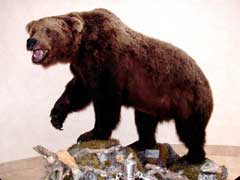
When
the .500 Magnum was developed, Tom Kelly of Smith &
Wesson shot this bear as part of the field testing.
The bear now greets visitors to Smith & Wesson
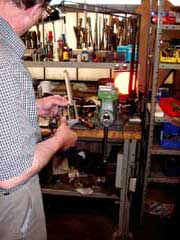
A
craftsman in the Performance Center works on a .500 Magnum
revolver, though not one of the John Ross guns.
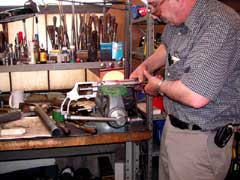
Assembling
a .500 Magnum revolver in the Performance Center; note that
unlike the Ross revolvers this one uses the muzzle brake.
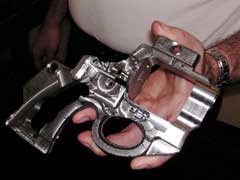
The
forging from which the .500 Magnum revolver frames are
fabricated.
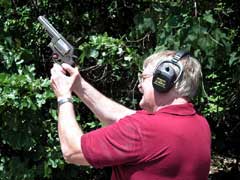
Muzzle
flip is noticeable with .500 Special loads, but not
unpleasant.
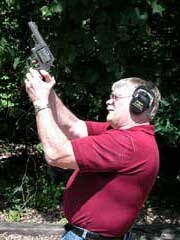
With
.500 Magnum 350 grain Cor-Bon loads, muzzle flip is more
noticeable but Thompson’s head was still not in danger!
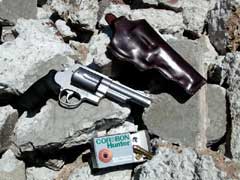
The
John Ross PC .500 ready for the field with Cor-Bon .500 Magnum
loads and Ken Null’s holster.
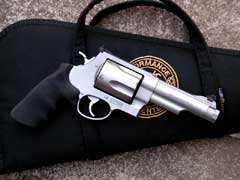
Note
the sleek lines of the Ross .500 due to the half lug and 5
inch barrel.
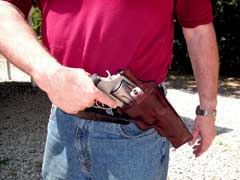
Thompson
drawing the Ross .500 Magnum from the Ken Null holster in
cross draw position. If
carrying a pack, this carry method would allow ease of access
to the gun.

The
big .500 holes in the barrel and cylinder are impressive.

25-yard
group with 275 grain Cor-Bon DPX .500 Magnum loads.
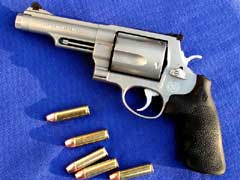
The
Ross .500 Magnum with a full cylinder of .500 Magnum loads.
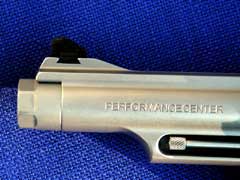
Note
the muzzle nut instead of muzzle brake on the Ross Performance
Center .500 Magnum.
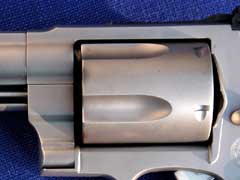
Shooters
gain about 100 fps due to the tighter cylinder gap on the Ross
revolvers.
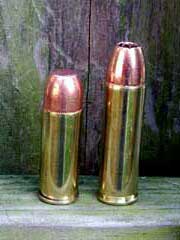
Cor-Bon
.500 Special round to left and .500 Magnum round to right.
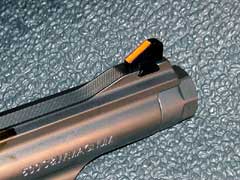
The
Millet dovetail front sight may changed by a gunsmith to suit
a specific load.
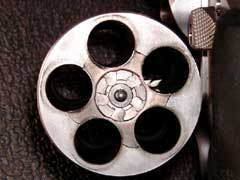
The
.500 magnum’s hefty cylinder is designed to handle hot
handloads as well as factory loads.
|
![]()